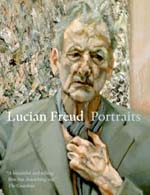Book Review: Lucian Freud Portraits catalogue
Angus Stewart admires the National Portrait Gallery’s superlative catalogue for Lucian Freud’s portraits


The National Portrait Gallery's exhibition of Lucian Freud's work is much enriched by its catalogue. The comments on the awesome and occasionally mystifying images, which won Freud world renown, are revealing. The 250 pages, a judicious mix of words and images, enable the reader to associate with the artist and better comprehend his work; if possible, it should be read in advance.
In his twenties, Michelangelo carved the Pietà in St Peter's, Rome, a mother grieving for her son. Freud, at the same age, painted his second wife and himself in a hotel bedroom in Paris, creating a quintessential study of played-out passion. Freud's silent lament is persuasive; we are moved to pay him the same judicious attention we give to the Florentine artist.
In the catalogue, John Richardson, Picasso's biographer and Freud's friend for nearly seven decades, introduces the artist and his milieu to the reader with perceptiveness and elegance. Sarah Howgate's essay sets the scene and reviews Freud's pre-eminence in British art. The American Michael Auping, who intermittently talked to Freud during his last two years, brings to the fore his technical virtuosity and explores his inter-play with his family and the friends who are the subjects of so many of his portraits.
The front cover of the catalogue features Kitty Garman, daughter of Jacob Epstein and Freud's first wife. A precise and formal study, it is reminiscent of the 15th-century portraits by Antonello da Messina. The back cover is a 1985 study of the artist, a searing analysis evocative of Rembrandt's self-portraits. Soon after painting his last work included here, Portrait of the Hound, Freud died, on July 20, 2011. Finished or not, this image has a shimmering and translucent presence.
Freud moved in privileged circles. Aristocrats and connois-seurs were his playmates and often the subjects or inspiration of his images. Jacob Rothschild, Baron Thyssen, Andrew Parker-Bowles, David Hockney and The Queen have sat for him. He was a star when he was young, and as he aged, he became a mythical and contrary creature, a town-dweller devoted to dogs and horses, a shaman portraying city-folk as naked and suscep-tible as animals in a field.
It is puzzling that a man so grounded in nature sometimes rejects gravity. Large Interior, W11 (after Watteau) and Standing by the Rags are examples of his stubborn refusal to acknowledge defeat. He insisted his failures were worthwhile, and the foolish were fooled. His force of personality was such that he could sell stale bread as fresh.
No matter. Many, many works are sublime. The puzzles in Freud's work are, to some extent, resolved by juxtaposing one canvas with photo-graphic reproductions of other works. It is by seeing an original work in the flesh associated with those illustrated in the catalogue that the onlooker will find congruencies and visual quirks to mull over.
Exquisite houses, the beauty of Nature, and how to get the most from your life, straight to your inbox.
Unfortunately, two of Freud's magisterial paintings are not in the exhibition. They are both jewels, so their absence should be noticed and mourned. In 1952, Freud painted the head of Francis Bacon on a small copper plate. In 1988, it was stolen when on loan to a gallery in Berlin. Also in 1952, Freud painted his then mistress, Henrietta Moraes, holding a blanket. It was a tour de force. These works confirm Freud's high accomplishment.
I regret their absence, as I am sure do the curators. Thirty years ago, the artist and critic Lawrence Gowing admired Freud's paintings and went on to describe the artist as an enchanting gossip, a frequenter of society, high and low; a man who fled when scared, yet who scared others. Gowing also found him irresolute in life, a characteristic confirmed by the number of women, the number of children, and his repetitive application of paint: ‘a sequence of dab-pat-wipe-smear-blot'.
The body of work in this helpful catalogue confirms Gowing's prediction that Freud is a painter in the European tradition, one of those artists likely to influence what is to come.
to Country Life and save over £50 a year
Country Life is unlike any other magazine: the only glossy weekly on the newsstand and the only magazine that has been guest-edited by His Majesty The King not once, but twice. It is a celebration of modern rural life and all its diverse joys and pleasures — that was first published in Queen Victoria's Diamond Jubilee year. Our eclectic mixture of witty and informative content — from the most up-to-date property news and commentary and a coveted glimpse inside some of the UK's best houses and gardens, to gardening, the arts and interior design, written by experts in their field — still cannot be found in print or online, anywhere else.
